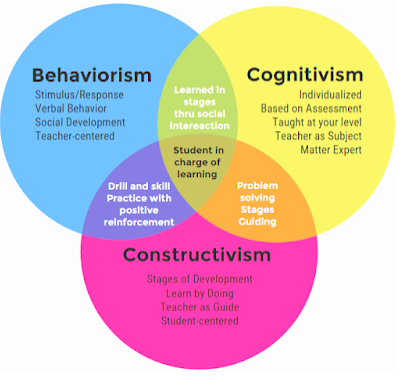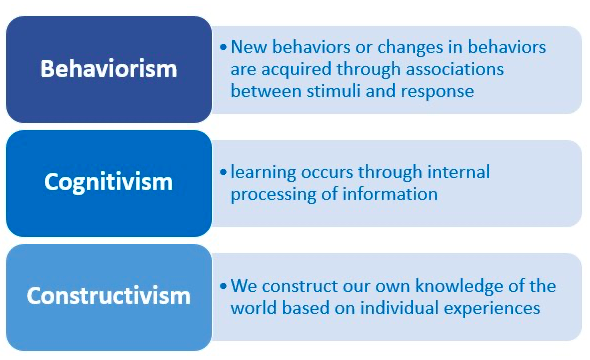So far everything I have read in EDCI 339 has made me very curious about online learning. What’s odd to me is that I have taken many online courses and I still am, yet not once I asked myself “how did online courses become the way they are?”. Even though learning is supposed to be involved around the learner, I believe that over the years, education in schools has made me dogmatic towards learning; you do the assignment, and you write a quiz. But, I never ask how learning is the way it is? Why am I doing this assignment collectively when I can do it by myself? Upon reflecting on this week’s reading, Learning Theories, and Online Learning, I feel traditional in-classroom learning impacts the students negatively by making them “dogmatic and blinkered by unchallenged assumptions” (Bates, 2014).
Look at today, who would have known that a pandemic will happen and all the schools will shut down. However, during these times, online learning prevailed allowing me to continue my education and obtain my degree. However, there are so many intricate things that happened in the world of online learning that made it what it is today. What put things into perspective for me was looking at 25 years of ed tech by Weller (2020); when I just think about Wikis (1998) and Open textbooks (2013), my mind makes the connection that ‘wikis were available online and textbooks contain a lot of knowledge like wikis, so if one is available online, only a matter of time till other will be as well’, and the evolution from wikis to open textbooks seems linear and gradual.
But, I had difficulty imagining the evolution of online learning to what it is now and how it managed to be so widespread, while satisfies and accomodating every student’s learning needs. “As online learning, technology-based teaching, and informal digital networks of learners have evolved, new theories of learning are emerging” (Bates, 2014). Reading this quote made things come together, “THEORIES” have evolved and changed, we are learning things through various theories! After reading week 5’s reading, I realized that I have been learning through cognitivism. Upon reading Shelby’s blog and connecting with her in my social pod’s group chat, I realized that cognitivism, behaviorism, and constructivism are interconnected.

But what intrigued me more is that when writing blogs for EDCI 339, I am the use cognitivism theory of learning. But it is associated more with constructivist epistemological understanding. Bates (2014) describes cognitivism associated with constructivism epistemological understanding as placing “a strong emphasis on learners [to develop] personal meaning […] through reflection, […] and construction of knowledge through conscious mental processing”. I go over weekly readings, sit back, analyze what I read, and reflect on my personal experiences to construct knowledge. Then, I write what I have learned into blogs and share with my peers and they do the same. This is a part of the Online Collaborative Learning theory. In conclusion, writing a blog is associated with four online learning theories: cognitivism, constructivism, online collaborative learning, and behaviorism. Understanding this put learning and education into a new light for me; I realized that a course is not just a course, many small intricate things are going on that allows the learner to achieve their goal.

By interacting with others in social pods, I expand out knowledge by conversing about my ideas and listening to my peers; as described by constructivism learning theory. Following conversations about our learnings, I reflect on what I learned from my peers and readings and connect with them via my personal experiences, which is in line with cognitive learning theory. And lastly, after reflecting on my learning and making connections with my understanding, I communicate my knowledge via blog posts to make sense of why online learning is the way it is, as described by the behaviorism learning theory. Earlier in the week, upon conversing with Shelby and reading her blog, I realized that I frequently use utilize constructivism, cognitivism, and behaviorism theories of learning. I reflected upon my understanding of these theories and tried to connect them with my experiences and used that reflection to make sense of my learning. The reflection I made was associated with my field of study, Chemistry. As a week, I did an experiment during which I created Quantum Dots. I got the data that showed that over time, the size of quantum dots increased. I reflected on my learning of quantum dots to understand why their radii increases due to the production of selenium by-product (cognitivism). Upon making this connection, I used this information to engage with my data for further analysis and processing (constructivism) and lastly, hypothesize why selenium byproduct increases and the future of the research (behaviorism).
Also, I strongly prefer learning through cognitivism theory. I believe that when I can relate to what I am learning with my experiences, I understand the concept better. To me, your experiences are like a string, and what you learn is also a string. When you overlap your learning with experience, you get a stronger string. This stronger string to me represents an understanding of the material; the stronger the string, the stronger the understanding. We are studying during a time that none of the thought would ever come, a pandemic! Yet, cognitivism has allowed me to continue my education and build connections between my learning and personal experience. The benefits of the cognitivism theory of learning for me directly support Bates’s statement that “a good theory helps us make informed decisions in areas of uncertainty” (2014).
Connecting this week’s reading with “25 years of ed-tech,” I think instructors should be vocal about learning theories as they humanize learning. I think pandemic is the time to thrive and find new creative measures, rather than sticking to the old ways during these modern times. Also, something I was very fascinated by was behaviorism. I have been taught that the human brain is very complex and at times, it has a mind of its own. Yet, reading about behaviorism contradicted my understanding of the human brain that the brain is a complex system that does numerous things, yet it can be primed. The idea of finding an organ as something that can be primed is very fascinating to a premed student like me. Upon doing research on this topic, I found this video, describing the difference between classical and operant conditioning. Research on this topic is conducted on animals but, I am sure that subconsciously, many of us have been conditioned to certain stimuli.
References:
Bates, T.(2014).Learning Theories and Online
Learning. [Blog post]. Retrieved from
https://www.tonybates.ca/2014/07/29/learning-theories-and-online-learning/
Weller, M. (2020). 25 Years of ed tech. AU Press. Retrieved from https://read.aupress.ca/read/25-years-of-ed-tech/section/e69021f2-91b6-4ca4-9d0b-81d3e9748707
Kelly, James. (2012). “Learning Theories Behaviorism, Cognitive And Constructivist”. Thepeakperformancecenter.Com, https://thepeakperformancecenter.com/educational-learning/learning/theories/. Accessed 18 Oct 2020.
Ahmad, Amish. “3 Major Learning Theories :Behaviorism, Cognitivism And Constructivism”. Someone’s White Star, 2020, https://hamizahmohdisa.blogspot.com/2019/10/3-major-learning-theories-behaviorism.html?m=0. Accessed 24 Oct 2020.
Hey Pranav, thank you for sharing your thoughts. I like how you talked about the different learning theories and touched on how our course resembles an online collaborative community. I like how you included the string analogy as it helped me understand what you were trying to portray. I am curious what you think of connectivism and if you think you would do well with this type of learning environment. Rebecca Bathurst Hunt talks a lot about this learning theory and she has made sketch notes to help understand it. I have embedded one of her drawings in my blog post if you are interested. I am also interested in watching the video you described, can you embed the video in your post? I am curious what new methods you think will stay after the pandemic is over, and what technologies would be beneficial in the classroom.
It was fascinating seeing how fast technology advanced, and how it impacts our learning today. From learning tools only being available in books, to now everything being available with the click of a button, it is noticeable that our technology has advanced a lot. I really liked how you brought in the quote from the week 5 reading. This quote shows how the more our technology advances, the more our understanding how we learn (especially online) advances. One thing that stood out to me the most was the Venn diagram connecting behaviourism, cognitivism, and constructivism. This really made me understand how they are all interconnected. Putting these pictures in your writing makes these main points stand out to readers and draws your attention to these important illustrations. Regarding the end of the post, I really liked how you put in the video link in text! You have done an extremely thorough job of this blog post, and I am looking forward to your next post.